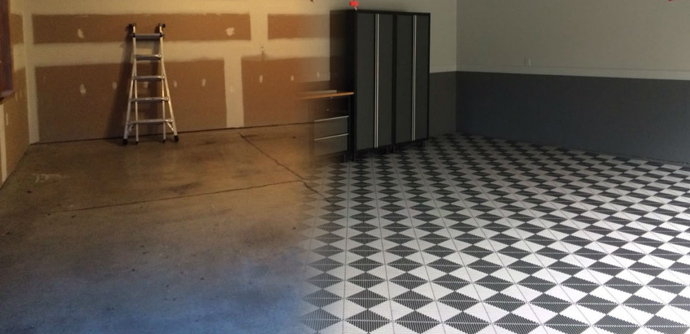A Garage Transformation – Before & After
It’s amazing how a garage transformation can happen with just a few upgrades. Even though it’s the garage, this is a space that you use daily – whether it’s for parking your car, working on a project, working out or as an extra space to store items. For this post, we have an excellent example that takes you from start to finish.
Installing Garage Floor Insulation
If you’re going to convert your garage, you’ll need to insulate your garage floor. Not only will this make it warmer, but the floor will be a lot safer than bare concrete. It’s not a difficult job, although it will take some time and you’ll need the proper materials in order to properly insulate the garage floor.
Step 1 – Preparation
Before you start to insulate the garage floor, you need to clear and clean it. Start by moving everything out of the garage and sweep the concrete garage floor clean. You’ll need to clean up any stains on the floor that could potentially seep into the insulation. Once you’ve done this, allow to dry and then use a shop vac to finish cleaning the floor.
Measure the length and width of the garage. You’ll need by 2 by 4 inch lumber to be the surround and the joists on the floor. The joists will run across the garage, spaced 2 feet apart. You’ll also need to buy polystyrene board insulation. This should be 2 inches thick and 2 feet wide.
Step 2 – Framing
Start by putting in the surround of timber on the garage floor. Use the timber with the 4 inch side down. Drill through at 12 inch intervals into the concrete and put in concrete screws to hold the frame firm
Once you’ve done this all around the perimeter of the garage floor, you’re ready to start putting in the joists. Begin at one end of the garage. Measure in 2 feet on either side and lay a piece of 2 by 4 inch timber. Put in place between the frame, so the gap from frame to joist is 2 feet. Drill and screw into place on the garage floor. Continue along the floor, making sure there’s a 2 feet gap between the joistsStep 3 – Insulation
Once you have all joists secure on the garage floor, it’s time to put in the insulation. The polystyrene board insulation won’t be long enough to stretch across the entire garage. This means you’ll need to connect several boards. Do this with duct tape, which will comply with most building codes. It stops the boards possible shifting on the garage floor. Lay the insulation in place, making sure it’s flat on the floor. Move on to the next gap and repeat.
To make sure you don’t step on the insulation as you move along, use boards over the joists for walking and kneeling. Continue with the insulation until you’ve covered all the gaps.
Step 4 – Plywood
Now that you’ve laid the insulation, you need to cover it. Use 1/3 inch plywood for this. Start in one corner of the garage and fit the edges snug against the walls. Screw down onto the joists. Continue across the width of the garage, and then along the length of the garage until you’ve covered the entire garage floor.
Steps to a Garage Flooring Installation
Step 1: Clean up and consolidate
We can all be a little guilty of it. We have an item that fits nowhere in our house, so we stick it in the garage. We have a container full of items and all of the closets are full and there’s no other place to store it, except for the garage. This is how our garage becomes overfilled and soon can look like a space that can never return to being functional or enjoyable. However, this certainly isn’t the case.
When we work on an upgrade, a transformation, the first step is to clean out the items that you really don’t need. You’ll need a good half day to a full day to really assess what you want to keep and to also think ahead about how you’ll continue to store these items post garage transformation.
You might find items that are still very useful, but realistically, you don’t use the item often enough. Consider making a list of all the items that can be reused by someone else. You can give away, donate or even hold a yard sale to get rid of the items you no longer use.
For the items that you want to keep, think about how you will store them. Will you put cabinets up on the wall? Will you opt for cabinets that can free stand on their own? How about an overhead storage system? While you don’t have to make the exact decision on this clean up and clear out day, it’s something to think about as you plan the tasks ahead and of course, your budget.

Step 2: Painting walls renews the garage
Some homes are built with finished walls complete with paint depending on the home builder and the choices of the original homeowner. This featured garage did not come complete with paint. Most garages that are finished tend to have white painted walls which is great for staying neutral for any homeowner. However, you can certainly give a more cozy look by choosing some other colors for your walls.
This garage has been painted with greys in two shades. These paint colors also allow for flexibility in a homeowner’s decor. It is neutral enough to complement any other colors that will be in this space including future cabinets and storage systems.
Step 3: Floor it
Now, you are ready for your garage flooring,With our interlocking tiles, your flooring can be installed in just a few hours. Unlike epoxies, you don’t need several steps of prep which greatly influence its ability to adhere to the surface. The prep needed before installing our tiles is a shop vac or sweep of the floor to eliminate any debris.
Once your starting point is determined, you will continue to interlock the tiles until your floor is covered. You may end up with one row that needs to be cut alongside the wall. Refer to our installation instructions for the recommended tools.
Step 4: Install or add cabinets or organizers
Now that your garage has a fresh coat of paint and new flooring, it’s time to determine how you’ll organize the items that you’ve decided to keep in your garage. Start with cabinets and decided if you would like to mount cabinets to the wall or to buy a free standing cabinet that can be moved at any time.
Will you have a workstation in your garage? You’ll need to determine the best spot for your workbench and generally, the locations of your cabinets will complement the workbench.

Do you have additional storage containers filled with seasonal items that won’t be accessed for months? You may want to consider an overhead storage system to free up ground space, or you can select some storage bin systems that will keep your items organized while being able to be stacked in an orderly fashion.
Remember, now that you’ve transformed your garage, you want to figure out a realistic way to store and access your items in the garage.












This site is absolutely fabulous!